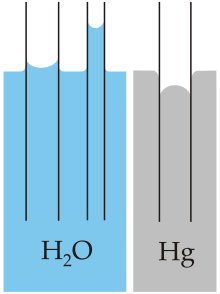Hiện tượng mao dẫn
Hiện tượng mao dẫn là hiện tượng chất lỏng tự dâng lên cao trong vùng không gian hẹp mà không cần, thậm chí ngược hướng, với ngoại lực (như trọng lực). Hiện tượng có thể quan sát ở các ống tiết diện nhỏ, các khe rất hẹp giữa hai tấm kính, nhựa, giữa các răng của bàn chải,... Nguyên nhân do bản thân trong chất lỏng có lực dính ướt (lực làm cho dung dịch giữ lại trên bề mặt các chất và sức căng bề mặt). Khi lực dính ướt lớn hơn sức căng bề mặt thì dung dịch được kéo lên trên bề mặt chất lỏng một khoảng. Ví dụ như dung dịch bị hút vào các khe nứt. Nếu chất lỏng có sức căng bề mặt lớn hơn lực dính ướt. Ví dụ: Nước trên lá dọc mùng dung dịch vo tròn để năng lượng liên kết lớn nhất khi đó dung dịch không bị dính vào bề mặt. Vậy hiện tượng mao dẫn là hiện tượng lực dính ướt của dung dịch thắng được sức căng bề mặt nhằm kéo dung dịch lên trên các ống dẫn.[1]
Lịch sử
[sửa | sửa mã nguồn]
Việc quan sát đầu tiên của hiện tượng mao dẫn được Leonardo da Vinci thực hiện.[2][3] Một cựu sinh viên của Galileo, Niccolò Aggiunti, được cho là đã xem xét hiện tượng mao dẫn[4]. Năm 1660, hiện tượng mao dẫn vẫn là một điều mới mẻ đối với nhà hoá học người Ireland Robert Boyle, khi ông nói rằng "một số người đàn ông người Pháp tò mò" đã quan sát thấy rằng khi một ống tuýp được nhúng vào nước, "nước trong ống sẽ cao lên". Boyle sau đó báo cáo một thí nghiệm trong đó ông nhúng một ống mao dẫn vào rượu vang đỏ và sau đó đưa ống vào chân không một phần. Ông nhận thấy rằng chân không không có ảnh hưởng đáng kể nào về chiều cao của chất lỏng trong ống mao dẫn, do đó hành vi của chất lỏng trong các ống mao dẫn là do một hiện tượng khác với những gì đã điều chỉnh trong các ống đo áp suất khí quyển bằng thủy ngân.[5]
Các nhà khoa học khác cũng nhanh chóng nghiên cứu hiện tượng này.[6] Một số người (ví dụ Honoré Fabri,[7] Jacob Bernoulli[8]) nghĩ rằng chất lỏng tăng lên trong các ống mao dẫn vì không khí không thể đi vào các mao mạch dễ dàng như chất lỏng, vì vậy áp suất không khí bên trong ống thấp hơn. Những người khác (ví dụ: Isaac Vossius,[9] Giovanni Alfonso Borelli,[10] Louis Carré,[11] Francis Hauksbee,[12] Josia Weitbrecht[13]) nghĩ rằng các hạt chất lỏng bị hút vào nhau và bị hút vào thành ống mao dẫn.
Mặc dù các nghiên cứu thực nghiệm vẫn tiếp tục trong thế kỷ 18, [14] một phương pháp điều trị định lượng thành công mao mạch [15] đã không đạt được cho đến năm 1805 bởi hai nhà điều tra: Thomas Young của Vương quốc Anh [16] và Pierre-Simon Laplace của Pháp.[17 ] Họ rút ra phương trình Young - Laplace của hành động mao dẫn. Đến năm 1830, nhà toán học người Đức Carl Friedrich Gauss đã xác định các điều kiện biên điều chỉnh hành động mao dẫn (tức là, các điều kiện tại giao diện rắn-lỏng).[18] Năm 1871, nhà vật lý người Anh William Thomson, Nam tước thứ nhất Kelvin đã xác định ảnh hưởng của sụn đối với áp suất hơi của chất lỏng. Một mối quan hệ được gọi là phương trình Kelvin.[19] Nhà vật lý người Đức Franz Ernst Neumann (1798-1895) sau đó đã xác định sự tương tác giữa hai chất lỏng bất biến.[20]
Bài báo đầu tiên của Albert Einstein, được đệ trình cho Annalen der Physik vào năm 1900, là về mao mạch.[21] [22]
Ví dụ
[sửa | sửa mã nguồn]Bấc đèn dầu thấm dầu ở dưới và đưa lên phía trên nhờ hiện tượng mao dẫn qua các lỗ nhỏ trong bấc đèn, khăn giấy thấm nước cũng nhờ hiện tượng mao dẫn.
Cây dùng hiện tượng mao dẫn để dẫn nước từ rễ lên các bộ phận thông qua hệ thống mạch.
Để nghiên cứu hiện tượng mao dẫn, người ta dùng ống mao dẫn có tiết diện nhỏ.
Tham khảo
[sửa | sửa mã nguồn]- ^ http://science.jrank.org/pages/1182/Capillary-Action.html
- ^ See:
- Manuscripts of Léonardo de Vinci (Paris), vol. N, folios 11, 67, and 74.
- Guillaume Libri, Histoire des sciences mathématiques en Italie, depuis la Renaissance des lettres jusqu'a la fin du dix-septième siecle [History of the mathematical sciences in Italy, from the Renaissance until the end of the seventeenth century] (Paris, France: Jules Renouard et cie., 1840), vol. 3, page 54 Lưu trữ 2016-12-24 tại Wayback Machine. From page 54: "Enfin, deux observations capitales, celle de l'action capillaire (7) et celle de la diffraction (8), dont jusqu'à présent on avait méconnu le véritable auteur, sont dues également à ce brillant génie." (Finally, two major observations, that of capillary action (7) and that of diffraction (8), the true author of which until now had not been recognized, are also due to this brilliant genius.)
- C. Wolf (1857) "Vom Einfluss der Temperatur auf die Erscheinungen in Haarröhrchen" (On the influence of temperature on phenomena in capillary tubes) Annalen der Physik und Chemie, 101 (177): 550–576; see footnote on page 551 Lưu trữ 2014-06-29 tại Wayback Machine by editor Johann C. Poggendorff. From page 551: "... nach Libri (Hist. des sciences math. en Italie, T. III, p. 54) in den zu Paris aufbewahrten Handschriften des grossen Künstlers Leonardo da Vinci (gestorben 1519) schon Beobachtungen dieser Art vorfinden;... " (... according to Libri (History of the mathematical sciences in Italy, vol. 3, p. 54) observations of this kind [i.e., of capillary action] are already to be found in the manuscripts of the great artist Leonardo da Vinci (died 1519), which are preserved in Paris;...)
- ^ More detailed histories of research on capillary action can be found in:
- David Brewster, ed., Edinburgh Encyclopaedia (Philadelphia, Pennsylvania: Joseph and Edward Parker, 1832), volume 10, pp. 805–823 Lưu trữ 2016-12-24 tại Wayback Machine.
- Maxwell, James Clerk; Strutt, John William (1911). . Trong Chisholm, Hugh (biên tập). Encyclopædia Britannica. 5 (ấn bản thứ 11). Cambridge University Press. tr. 256–275.
- John Uri Lloyd (1902) "References to capillarity to the end of the year 1900," Lưu trữ 2014-12-14 tại Wayback Machine Bulletin of the Lloyd Library and Museum of Botany, Pharmacy and Materia Medica, 1 (4): 99–204.
- ^ In his book of 1759, Giovani Batista Clemente Nelli (1725–1793) stated (p. 87) that he had "un libro di problem vari geometrici ec. e di speculazioni, ed esperienze fisiche ec." (a book of various geometric problems and of speculation and physical experiments, etc.) by Aggiunti. On pages 91–92, he quotes from this book: Aggiunti attributed capillary action to "moto occulto" (hidden/secret motion). He proposed that mosquitoes, butterflies, and bees feed via capillary action, and that sap ascends in plants via capillary action. See: Giovambatista Clemente Nelli, Saggio di Storia Letteraria Fiorentina del Secolo XVII... [Essay on Florence's literary history in the 17th century,... ] (Lucca, (Italy): Vincenzo Giuntini, 1759), pp. 91–92. Lưu trữ 2014-07-27 tại Wayback Machine
- ^ Robert Boyle, New Experiments Physico-Mechanical touching the Spring of the Air,... (Oxford, England: H. Hall, 1660), pp. 265–270. Available on-line at: Echo (Max Planck Institute for the History of Science; Berlin, Germany) Lưu trữ 2014-03-05 tại Wayback Machine.
- ^ See, for example:
- Robert Hooke (1661) An attempt for the explication of the Phenomena observable in an experiment published by the Right Hon. Robert Boyle, in the 35th experiment of his Epistolical Discourse touching the Air, in confirmation of a former conjecture made by R. Hooke. [pamphlet].
- Hooke's An attempt for the explication... was reprinted (with some changes) in: Robert Hooke, Micrographia... (London, England: James Allestry, 1667), pp. 12–22, "Observ. IV. Of small Glass Canes." Lưu trữ 2016-12-24 tại Wayback Machine
- Geminiano Montanari, Pensieri fisico-matematici sopra alcune esperienze fatte in Bologna... Lưu trữ 2016-12-29 tại Wayback Machine [Physical-mathematical ideas about some experiments done in Bologna... ] (Bologna, (Italy): 1667).
- George Sinclair, Ars Nova et Magna Gravitatis et Levitatis Lưu trữ 2017-11-03 tại Wayback Machine [New and great powers of weight and levity] (Rotterdam, Netherlands: Arnold Leers, Jr., 1669).
- Johannes Christoph Sturm, Collegium Experimentale sive Curiosum [Catalog of experiments, or Curiosity] (Nüremberg (Norimbergæ), (Germany): Wolfgang Moritz Endter & the heirs of Johann Andreas Endter, 1676). See: "Tentamen VIII. Canaliculorum angustiorum recens-notata Phænomena,... " Lưu trữ 2014-06-29 tại Wayback Machine (Essay 8. Recently noted phenomena of narrow capillaries,...), pp. 44–48.
- ^ See:
- Honorato Fabri, Dialogi physici... ((Lyon (Lugdunum), France: 1665), pages 157 ff Lưu trữ 2016-12-24 tại Wayback Machine "Dialogus Quartus. In quo, de libratis suspensisque liquoribus & Mercurio disputatur. (Dialogue four. In which the balance and suspension of liquids and mercury is discussed).
- Honorato Fabri, Dialogi physici... ((Lyon (Lugdunum), France: Antoine Molin, 1669), pages 267 ff Lưu trữ 2017-04-07 tại Wayback Machine "Alithophilus, Dialogus quartus, in quo nonnulla discutiuntur à D. Montanario opposita circa elevationem Humoris in canaliculis, etc." (Alithophilus, Fourth dialogue, in which Dr. Montanari's opposition regarding the elevation of liquids in capillaries is utterly refuted).
- ^ Jacob Bernoulli, Dissertatio de Gravitate Ætheris Lưu trữ 2017-04-07 tại Wayback Machine (Amsterdam, Netherlands: Hendrik Wetsten, 1683).
- ^ Isaac Vossius, De Nili et Aliorum Fluminum Origine [On the sources of the Nile and other rivers] (Hague (Hagæ Comitis), Netherlands: Adrian Vlacq, 1666), pages 3–7 Lưu trữ 2017-04-07 tại Wayback Machine (chapter 2).
- ^ Borelli, Giovanni Alfonso De motionibus naturalibus a gravitate pendentibus (Lyon, France: 1670), page 385, Cap. 8 Prop. CLXXXV (Chapter 8, Proposition 185.). Available on-line at: Echo (Max Planck Institute for the History of Science; Berlin, Germany) Lưu trữ 2016-12-23 tại Wayback Machine.
- ^ Carré (1705) "Experiences sur les tuyaux Capillaires" Lưu trữ 2017-04-07 tại Wayback Machine (Experiments on capillary tubes), Mémoires de l'Académie Royale des Sciences, pp. 241–254.
- ^ See:
- Francis Hauksbee (1708) "Several Experiments Touching the Seeming Spontaneous Ascent of Water," Lưu trữ 2014-06-29 tại Wayback Machine Philosophical Transactions of the Royal Society of London, 26: 258–266.
- Francis Hauksbee, Physico-mechanical Experiments on Various Subjects... (London, England: (Self-published), 1709), pages 139–169.
- Francis Hauksbee (1711) "An account of an experiment touching the direction of a drop of oil of oranges, between two glass planes, towards any side of them that is nearest press'd together," Philosophical Transactions of the Royal Society of London, 27: 374–375.
- Francis Hauksbee (1712) "An account of an experiment touching the ascent of water between two glass planes, in an hyperbolick figure," Philosophical Transactions of the Royal Society of London, 27: 539–540.
- ^ See:
- Josia Weitbrecht (1736) "Tentamen theoriae qua ascensus aquae in tubis capillaribus explicatur" Lưu trữ 2014-06-29 tại Wayback Machine (Theoretical essay in which the ascent of water in capillary tubes is explained), Commentarii academiae scientiarum imperialis Petropolitanae (Memoirs of the imperial academy of sciences in St. Petersburg), 8: 261–309.
- Josia Weitbrecht (1737) "Explicatio difficilium experimentorum circa ascensum aquae in tubis capillaribus" Lưu trữ 2014-11-05 tại Wayback Machine (Explanation of difficult experiments concerning the ascent of water in capillary tubes), Commentarii academiae scientiarum imperialis Petropolitanae (Memoirs of the imperial academy of sciences in St. Petersburg), 9: 275–309.
 GIẢM
40%
GIẢM
40%
 GIẢM
38%
GIẢM
38%
 GIẢM
16%
GIẢM
16%
 GIẢM
19%
GIẢM
19%
 GIẢM
32%
GIẢM
32%
 GIẢM
27%
GIẢM
27%



